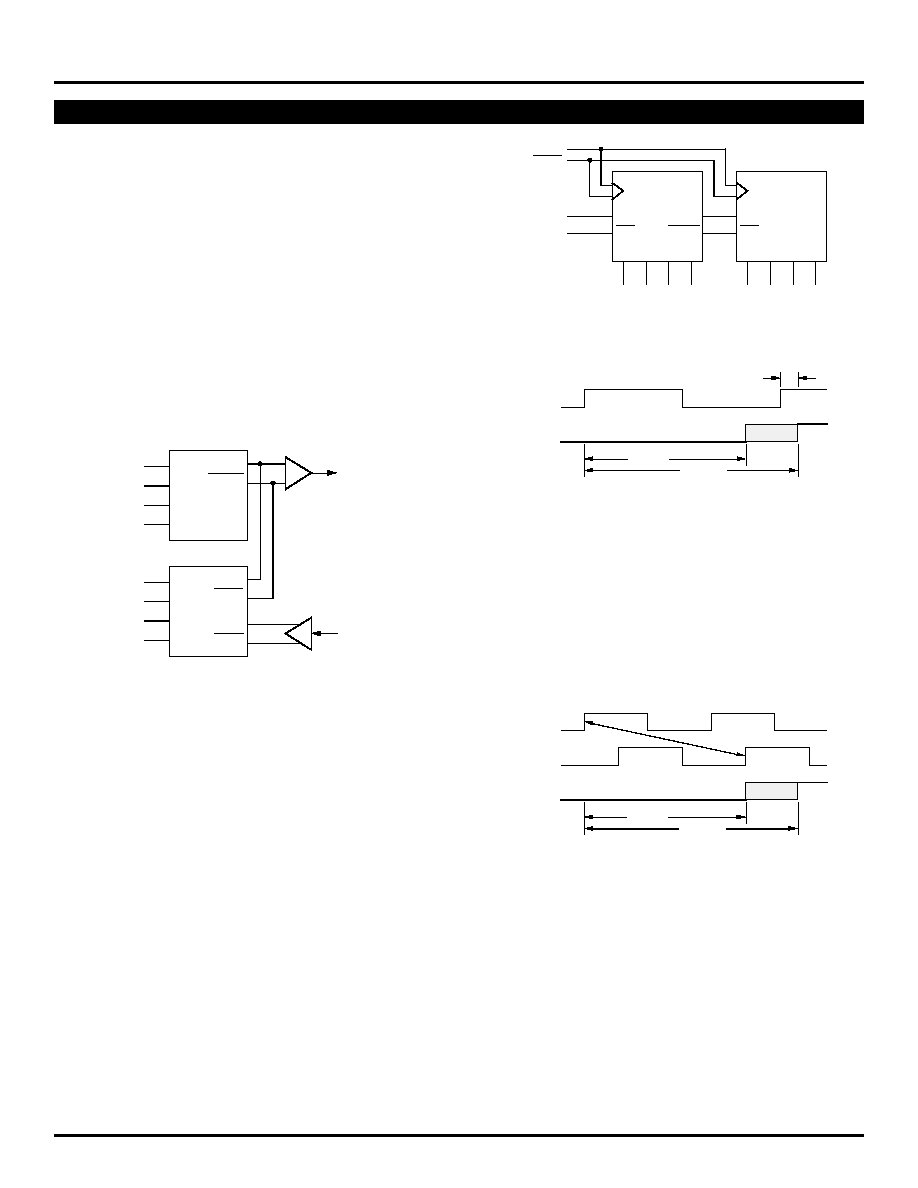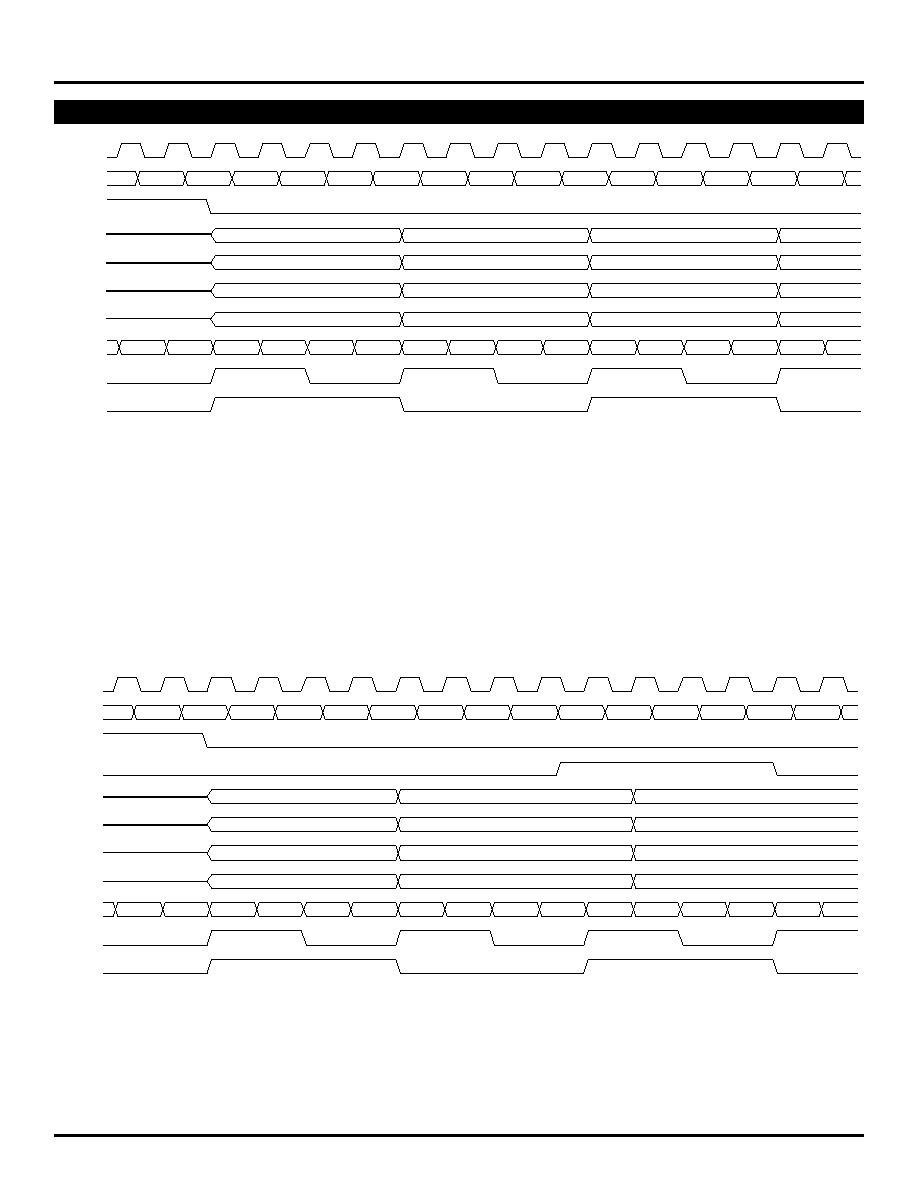
Pin
Function
SINA, SINA
Differential Serial Data Input A
SINB, SINB
Differential Serial Data Input B
SEL
Serial Input Select Pin
SOUT, SOUT
Differential Serial Data Output
Q0≠Q3
Parallel Data Outputs
CLK, CLK
Differential Clock Inputs
CL/4, CL/4
Differential
˜
4 Clock Output
CL/8, CL/8
Differential
˜
8 Clock Output
MODE
Conversion Mode 4-bit/8-bit
SYNC
Conversion Synchronizing Input
RESET
Input, Resets the Counters
V
CCO
V
CC
to Output
DESCRIPTION
FEATURES
s
On-chip clock
˜
4 and
˜
8
s
Extended 100E V
EE
range of ≠4.2V to ≠5.5V
s
2.5Gb/s data rate capability
s
Differential clock and serial inputs
s
V
BB
output for single-ended use
s
Asynchronous data synchronization
s
Mode select to expand to 8 bits
s
Internal 75k
input pull-down resistors
s
Fully compatible with Motorola MC10E/100E445
s
Available in 28-pin PLCC package
4-BIT SERIAL-to-PARALLEL
CONVERTER
The SY10/100E445 are integrated 4-bit serial-to-parallel
data converters. The devices are designed to operate for
NRZ data rates of up to 2.5Gb/s. The chip generates a
divide-by-4 and a divide-by-8 clock for both 4-bit conversion
and a two-chip 8-bit conversion function. The conversion
sequence was chosen to convert the first serial bit to Q
0
,
the second to Q
1
, etc.
Two selectable serial inputs provide a loopback capability
for testing purposes when the device is used in conjunction
with the E446 parallel-to-serial converter.
The start bit for conversion can be moved using the
SYNC input. A single pulse, applied asynchronously for at
least two input clock cycles, shifts the start bit for conversion
from Q
n
to Q
n-1
by one bit. For each additional shift required,
an additional pulse must be applied to the SYNC input.
Asserting the SYNC input will force the internal clock dividers
to "swallow" a clock pulse, effectively shifting a bit from the
Q
n
to the Q
n-1
output (see Timing Diagram B).
The MODE input is used to select the conversion mode
of the device. With the MODE input LOW (or open) the
device will function as a 4-bit converter. When the mode
input is driven HIGH, the data on the output will change on
every eighth clock cycle, thus allowing for an 8-bit conversion
scheme using two E445s. When cascaded in an 8-bit
conversion scheme, the devices will not operate at the
2.5Gb/s data rate of a single device. Refer to the applications
section of this data sheet for more information on cascading
the E445.
For lower data rate applications, a V
BB
reference voltage
is supplied for single-ended inputs. When operating at clock
rates above 500MHz, differential input signals are
recommended. For single-ended inputs, the V
BB
pin is tied
to the inverting differential input and bypassed via a 0.01
µ
F
capacitor. The V
BB
provides the switching reference for the
input differential amplifier. The V
BB
can also be used to AC
couple an input signal.
SY10E445
SY100E445
Rev.: D
Amendment: /0
Issue Date:
October, 1998
PIN CONFIGURATION
PIN NAMES
18
17
16
15
14
13
12
5
6
7
8
9
10 11
26
27
28
1
2
3
4
TOP VIEW
PLCC
J28-1
25 24 23 22 21 20 19
S
INB
SEL
V
EE
CLK
V
BB
S
INB
CLK
CL/8
V
CCO
CL/4
V
CCO
Q
3
CL/8
CL/4
S
OUT
V
CC
Q
0
Q
1
V
CCO
Q
2
S
OUT
SYNC
RESET
MODE
NC
S
INA
V
CCO
S
INA
1

3
SY10E445
SY100E445
Micrel
LOGIC DIAGRAM
AC CHARACTERISTICS
V
EE
= V
EE
(Min.) to V
EE
(Max.); V
CC
= V
CCO
= GND
T
A
= 0
∞
C
T
A
= +25
∞
C
T
A
= +85
∞
C
Symbol
Parameter
Min.
Typ.
Max.
Min.
Typ.
Max.
Min.
Typ.
Max.
Unit
Condition
f
MAX
Max. Conversion Frequency
2.0
--
--
2.0
--
--
2.0
--
--
Gb/s
1
2.5
--
--
2.5
--
--
2.5
--
--
NRZ
2
t
PLH
Propagation Delay to Output
ps
--
t
PHL
CLK to Q
1500
1800
2100
1500
1800
2100
1500
1800
2100
CLK to S
OUT
800
975
1150
800
975
1150
800
975
1150
CLK to CL/4
1100
1325
1550
1100
1325
1550
1100
1325
1550
CLK to CL/8
1100
1325
1550
1100
1325
1550
1100
1325
1550
t
S
Set-up Time
ps
--
SINA, SINB
≠100
≠250
--
≠100
≠250
--
≠100
≠250
--
SEL
0
≠200
--
0
≠200
--
0
≠200
--
t
H
Hold Time, SINA, SINB, SEL
450
300
--
450
300
--
450
300
--
ps
--
t
RR
Reset Recovery Time
500
300
--
500
300
--
500
300
--
ps
--
t
PW
Minimum Pulse Width
400
--
--
400
--
--
400
--
--
ps
--
CLK, MR
t
r
Rise/Fall Times
ps
--
t
f
20% to 80%
S
OUT
100
225
350
100
225
350
100
225
350
Other
200
425
650
200
425
650
200
425
550
NOTES:
1. Guaranteed for input clock amplitudes of 150mV to 800mV.
2. Guaranteed for input clock amplitudes of 150mV to 400mV.
T
A
= 0
∞
C
T
A
= +25
∞
C
T
A
= +85
∞
C
Symbol
Parameter
Min.
Typ.
Max.
Min.
Typ.
Max.
Min.
Typ.
Max.
Unit
Condition
I
IH
Input HIGH Current
--
--
150
--
--
150
--
--
150
µ
A
--
V
OH
Output HIGH Voltage
V
(S
OUT
only) 10E
≠1020
--
≠790
≠980
--
≠760
≠910
--
≠670
1
(S
OUT
only) 100E
≠1025
--
≠830 ≠1025
--
≠830 ≠1025
--
≠830
1
V
BB
Output Reference Voltage
V
10E
≠1.38
--
≠1.27 ≠1.35
--
≠1.25 ≠1.31
--
≠1.19
100E
≠1.38
--
≠1.26 ≠1.38
--
≠1.26 ≠1.38
--
≠1.26
I
EE
Power Supply Current
mA
--
10E
--
154
185
--
154
185
--
154
185
100E
--
154
185
--
154
185
--
177
212
NOTE:
1. The maximum VOH limit was relaxed from standard ECL due to the high frequency output design. All other outputs are specified with the standard 10E
and 100E VOH levels.
LOGIC DIAGRAM
DC CHARACTERISTICS
V
EE
= V
EE
(Min.) to V
EE
(Max.); V
CC
= V
CCO
= GND
LOGIC DIAGRAM
TRUTH TABLES
Mode
Conversion
L
4-Bit
H
8-Bit
SEL
Serial Input
H
A
L
B

4
SY10E445
SY100E445
Micrel
LOGIC DIAGRAM
APPLICATIONS INFORMATION
The SY10/100E are integrated 1:4 serial-to-parallel
converters. The chips are designed to work with the
E446 devices to provide both transmission and receiving
of a high-speed serial data path. The E445, under special
input conditions, can convert up to a 2.5Gb/s NRZ data
stream into 4-bit parallel data. The device also provides
a divide-by-four clock output to be used to synchronize
the parallel data with the rest of the system.
The E445 features multiplexed dual serial inputs to
provide test loop capability when used in conjunction
with the E446. Figure 1 illustrates the loop test
architecture. The architecture allows for the electrical
testing of the link without requiring actual transmission
over the serial data path medium. The SINA serial input
of the E445 has an extra buffer delay and, thus, should
be used as the loop back serial input.
Parallel
Data
To Serial
Medium
Parallel
Data
From Serial
Medium
SOUT
SOUT
SINA
SINA
SINB
SINB
Figure 1. Loop Test Architecture
Serial Input
Data
Q
7
Q
6
Q
5
Q
4
SOUT
SOUT
SIN
E445a
Q
3
SIN
Q
2
Q
1
Q
0
Q
3
Q
2
Q
1
Q
0
SIN
E445b
Q
3
SIN
Q
2
Q
1
Q
0
Clock
Clock
Parallel Output Data
Tpd CLK
to SOUT
Clock
100ps
800ps
1050ps
Figure 2. Cascaded 1:8 Converter Architecture
The E445 features a differential serial output and a
divide-by-8 clock output to facilitate the cascading of two
devices to build a 1:8 demultiplexer. Figure 2 illustrates
the architecture of a 1:8 demultiplexer using two E445s.
The timing diagram for this configuration can be found
on the following page. Notice the serial outputs (S
OUT
)
of the lower order converter feed the serial inputs of the
higher order device. This feedthrough of the serial inputs
bounds the upper end of the frequency of operation. The
clock-to-serial output propagation delay, plus the set-up
time of the serial input pins, must fit into a single clock
period for the cascade architecture to function properly.
Using the worst case values for these two parameters
from the data sheet, t
PD
CLK to S
OUT
= 1150ps or a
clock frequency of 950MHz.
The clock frequency is significantly lower than that of
a single converter. To increase this frequency, some
games can be played with the clock input of the higher
order E445. By delaying the clock feeding the second
E445 relative to the clock of the first E445, the frequency
of operation can be increased. The delay between the
two clocks can be increased until the minimum delay of
Perhaps the easiest way to delay the second clock
relative to the first is to take advantage of the differential
clock inputs of the E445. By connecting the clock for the
second E445 to the complimentary clock input pin, the
device will clock a half a clock period after the first E445
(Figure 4). Utilizing this simple technique will raise the
potential conversion frequency up to 1.5GHz. The divide-
by-eight clock of the second E445 should be used to
synchronize the parallel data to the rest of the system as
the parallel data of the two E445s will no longer be
synchronized. This skew problem between the outputs
can be worked around as the parallel information will be
static for eight more clock pulses.
clock-to-serial-out would potentially cause a serial bit to
be swallowed (Figure 3). With a minimum delay of 800ps
on this output, the clock for the lower order E445 cannot
be delayed more than 800ps relative to the clock of the
first E445 without potentially missing a bit of information.
Because the set-up time on the serial input pin is
negative, coincident excursions on the data and clock
inputs of the E445 will result in correct operation.
Tpd CLK
to SOUT
Clock b
800ps
1050ps
Clock a
Figure 3. Cascade Frequency Limitation




